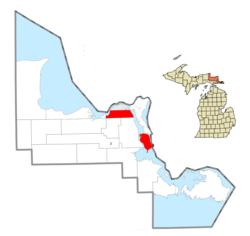Soo Township, Michigan | |
|---|---|
 Location within Chippewa County | |
| Coordinates: 46°25′11″N84°18′40″W / 46.41972°N 84.31111°W | |
| Country | United States |
| State | Michigan |
| County | Chippewa |
| Government | |
| • Supervisor | Larry Perron |
| Area | |
• Total | 67.9 sq mi (175.9 km2) |
| • Land | 50.1 sq mi (129.8 km2) |
| • Water | 17.8 sq mi (46.1 km2) |
| Elevation | 581 ft (177 m) |
| Population (2020) | |
• Total | 2,966 |
| • Density | 44/sq mi (17/km2) |
| Time zone | Eastern |
| ZIP code(s) | |
| Area code | 906 |
| FIPS code | 26-74620 [1] |
| GNIS feature ID | 1627091 [2] |
| Website | Official website |
Soo Township is a civil township of Chippewa County in the U.S. state of Michigan. The population was 2,966 at the 2020 census. [3]

